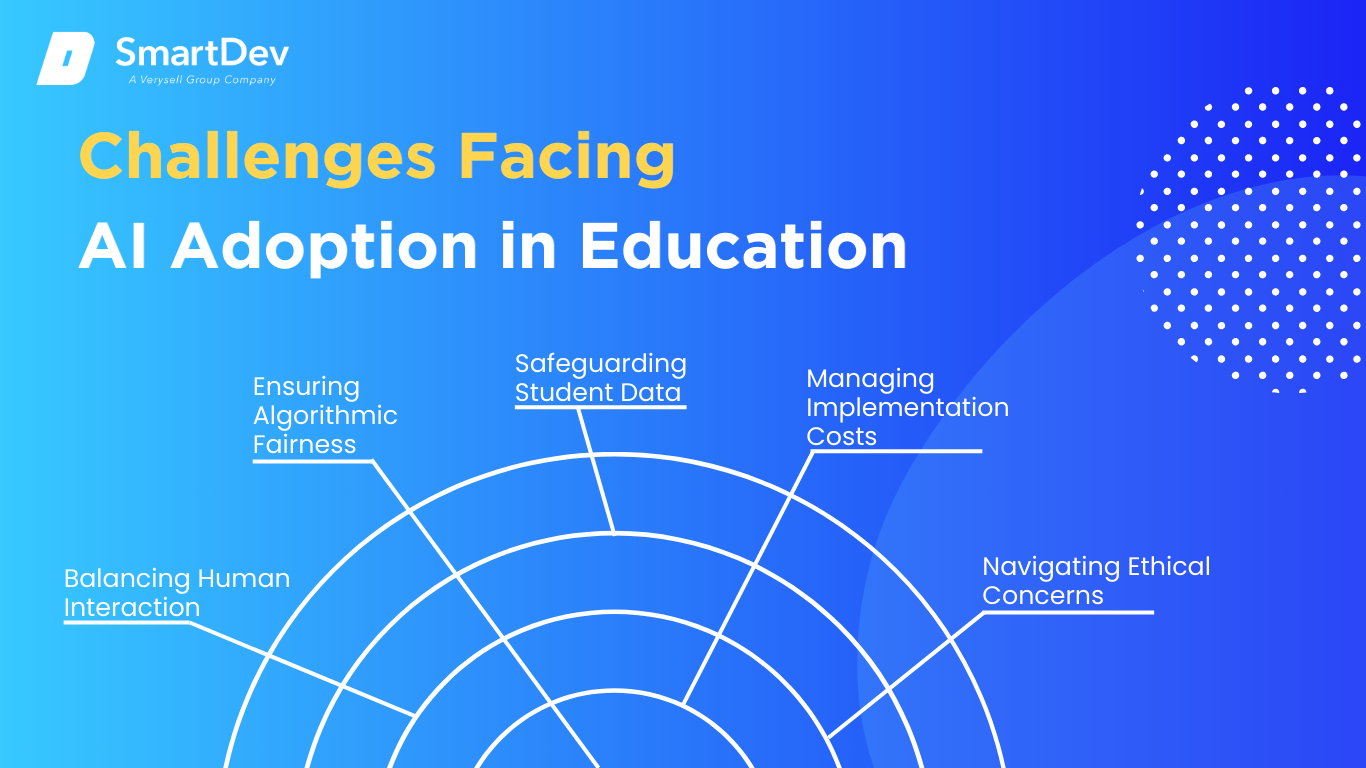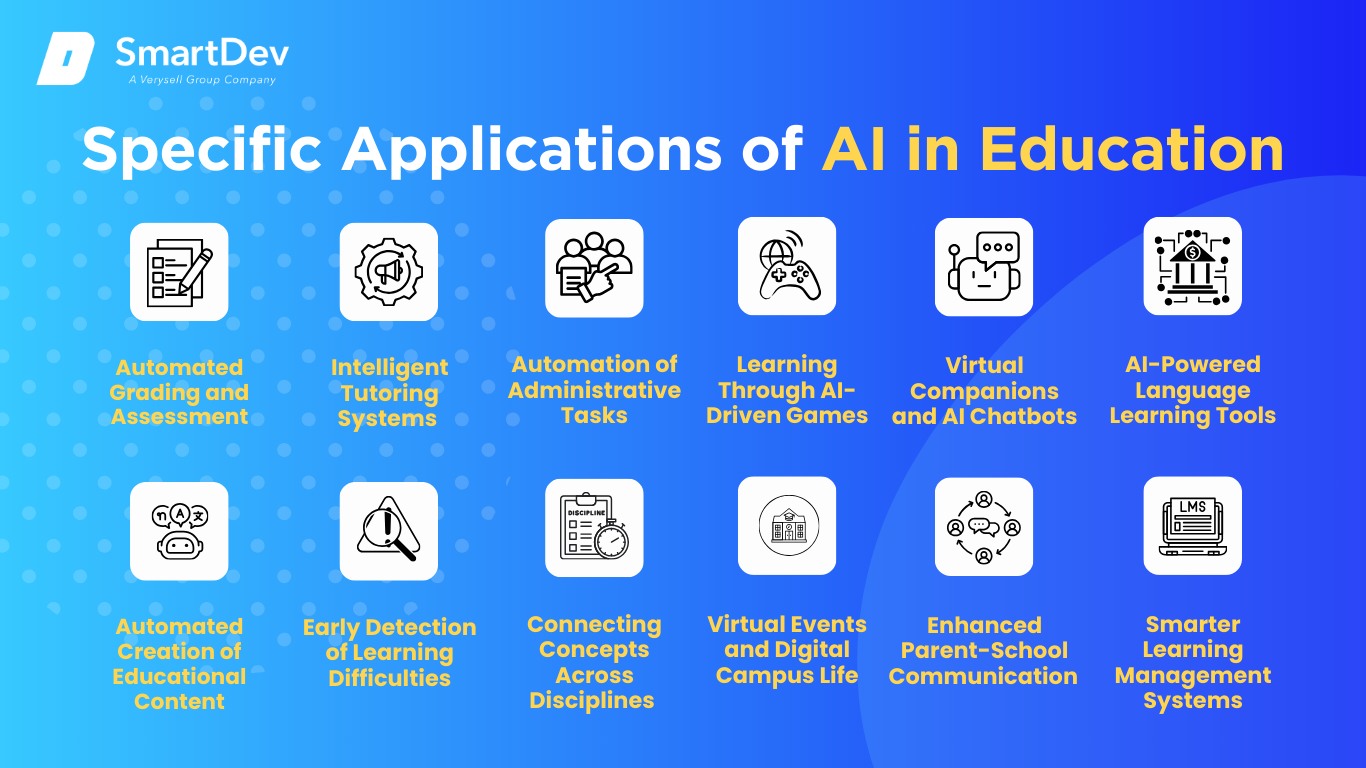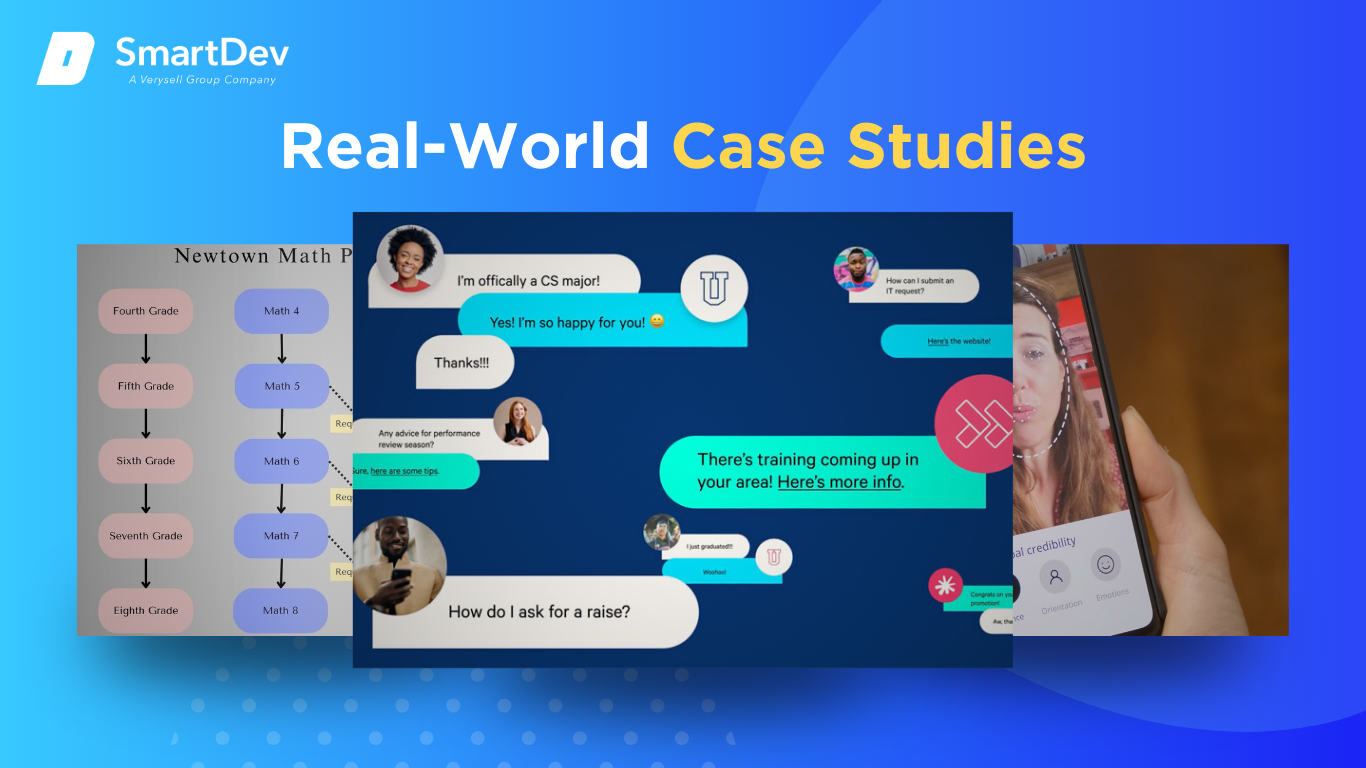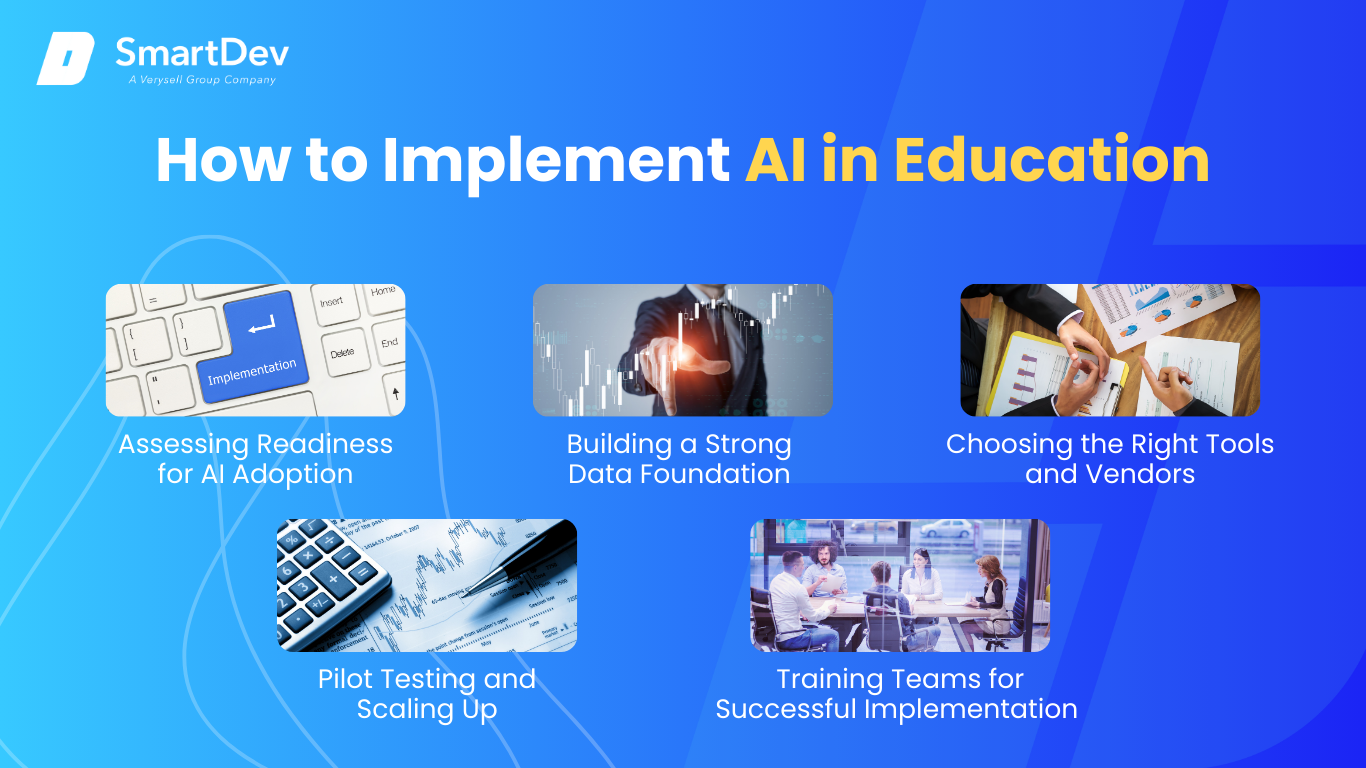Introduction
Artificial Intelligence (AI) increasingly makes its presence felt in classrooms, online learning platforms, and administrative offices.
AI use cases in education are no longer futuristic—they’re shaping today’s learning environments. From personalized learning to automated grading, AI applications in education improve outcomes, optimize workflows, and prepare students for a digital future.
This article delves into real-world AI use cases in education, highlighting their impact and implementation strategies for educators and edtech businesses.
What is AI and Why Does It Matter in Education?

The definition of AI and the importance of it in education
Definition of AI and its core technologies
Artificial Intelligence (AI) refers to technologies that mimic human cognition, enabling machines to learn, interpret data, and make decisions.
Core technologies like machine learning, natural language processing, and computer vision drive AI use cases in education.
These technologies power tools that personalize learning and automate tasks.
According to IBM, AI includes foundational tools such as machine learning, which enables predictive capabilities;
natural language processing, which supports conversational and linguistic interactions;
and computer vision, which allows systems to interpret and process visual inputs.
These technologies form the backbone of intelligent automation and offer powerful insights that enhance educational experiences across the board.
The Growing Role of AI in Transforming Education
The role of AI in education has expanded significantly over the past few years. No longer a futuristic concept, AI is now a core part of digital education strategies. AI use cases in education range from tailoring lesson plans to automating administrative tasks, enabling real-time support for students and teachers.
AI tools help teachers identify students’ strengths and weaknesses, adapt lesson plans in real time, and provide targeted support. These tools are also enhancing remote learning environments by making interactions more dynamic and responsive. As AI becomes more integrated into the daily operations of educational institutions, it’s transforming not just how students learn, but how educators teach and how institutions function.
Key Statistics and Trends Highlighting AI Adoption in Education
The adoption of AI in education is accelerating, driven by its proven impact and growing accessibility. According to HolonIQ’s 2023 report, the global AI in education market is expected to reach $20 billion by 2025, reflecting significant investment in AI-driven solutions.
A 2024 EdTech Survey found that 63% of educational institutions plan to adopt AI within the next three years, signaling widespread recognition of its potential. UNESCO’s 2023 study reported that AI-driven tutoring systems have improved student performance by up to 30% in some contexts, underscoring their effectiveness.
Additionally, a 2024 Google Education Report revealed that 80% of educators believe AI can significantly reduce administrative workloads, freeing them to focus on teaching. These trends highlight AI’s transformative role in education, making it a critical focus for both institutions and edtech businesses.
Business Benefits of AI in Education
AI use cases in education deliver significant advantages for institutions and edtech companies, transforming operations and student experiences.

5 Challenges of AI in Education that Business Owners have to face
1. Better Learning Outcomes
By personalizing learning experiences, AI ensures that content aligns with each student’s unique needs, learning pace, and preferences. Adaptive learning platforms analyze student performance in real-time, recommending resources and exercises to address gaps and reinforce strengths. For businesses, this translates into higher customer satisfaction, as students achieve better results and remain engaged with the platform, leading to improved retention rates and positive word-of-mouth.
2. Data-driven Insights
AI-powered analytics provide deep insights into student behavior, performance, and institutional efficiency. For example, predictive models can identify at-risk students, enabling timely interventions that improve graduation rates. For edtech companies, these insights inform product development, ensuring solutions meet market demands and deliver measurable value, ultimately enhancing return on investment.
3. Scalability in Education
AI enables institutions and platforms to serve larger audiences without compromising quality. Automated systems can handle thousands of students simultaneously, delivering personalized content and support at scale. This scalability is particularly valuable for edtech businesses seeking to expand their user base and enter new markets, as it reduces the need for proportional increases in staff or infrastructure.
4. Efficient Administrative Tasks
Administrative tasks like grading, scheduling, and enrollment management consume significant time and resources. AI automates these processes, allowing educators to focus on teaching and student engagement. For businesses, this efficiency translates into lower operational costs and the ability to allocate resources to innovation and growth.
5. Enhanced Accessibility
AI makes education more inclusive by supporting students with disabilities, language barriers, or limited access to resources. Tools like real-time captioning, translation, and adaptive interfaces ensure that learning is accessible to all. For businesses, this expands market reach, enabling them to serve diverse audiences and align with inclusivity goals.
Challenges Facing AI Adoption in Education
Despite the potential of AI use cases in education, challenges like data privacy, ethical concerns, and costs must be addressed to ensure successful adoption.

5 Challenges of AI in Education that Business Owners have to face
1. Safeguarding Student Data
Student data is highly sensitive, and AI systems rely on vast amounts of it to function effectively. Ensuring compliance with regulations like GDPR and FERPA is critical to maintaining trust. Breaches or misuse of data can erode confidence and result in legal repercussions.
Read more about AI and Data Privacy: Balancing Innovation with Security
2. Balancing Human Interaction
Over-dependence on AI risks diminishing the human element in education, which is essential for fostering creativity, empathy, and critical thinking. Striking a balance between automation and human interaction is crucial to preserving the holistic value of education.
3. Ensuring Algorithmic Fairness
AI systems can inadvertently perpetuate biases in their training data, leading to unfair outcomes. Developing inclusive, transparent AI models is essential to addressing this challenge.
4. Navigating Ethical Concerns
The use of AI in education raises ethical questions, such as the potential for surveillance. Transparent policies and ethical frameworks are necessary to ensure AI is used responsibly and respects student rights. Before investing in AI systems, awareness of ethical concerns is crucial. Read more at AI Ethics Concerns: A Business-Oriented Guide to Responsible AI
5. Managing Implementation Costs
Implementing AI requires significant investment in infrastructure, software, and training. For smaller institutions, these costs can limit access to AI’s benefits and exacerbate educational inequalities.
Specific Applications of AI in Education
Practical AI use cases in education are driving innovation across the sector. Below are key applications with real-world examples.

12 Use Cases of AI in Education
1. Automated Grading and Assessment
Automated grading systems use AI to evaluate assignments, quizzes, and exams, saving educators time and ensuring consistency. By leveraging Natural Language Processing and Machine Learning, these systems can assess not only multiple-choice tests but also essays and creative work, providing detailed feedback.
For example, Gradescope, used by institutions like Stanford University, employs AI to grade assignments 50% faster than manual methods. Turnitin uses AI to detect plagiarism and provide actionable feedback on writing. These tools reduce administrative burdens and scale effectively for large classes.
2. Intelligent Tutoring Systems
Intelligent tutoring systems act as personalized virtual tutors, adapting to a student’s learning style, pace, and knowledge level. Using Machine Learning, these systems analyze performance data to recommend tailored resources, exercises, and learning paths. Duolingo employs AI to adapt lessons in real-time, improving retention by 20%. Khan Academy suggests practice problems based on student progress, helping students master concepts at their own pace.
3. Automation of Administrative Tasks
AI streamlines repetitive administrative tasks such as course scheduling, enrollment management, and attendance tracking, reducing operational costs and improving efficiency. Civitas Learning optimizes course schedules using AI. Ellucian automates workflows for universities, from admissions to financial aid processing, allowing institutions to redirect resources to teaching and innovation.
4. Learning Through AI-Driven Games and Entertainment
AI-powered educational games transform learning into an interactive, engaging experience. These games adapt to a student’s skill level, maintain motivation, and develop problem-solving skills. Prodigy Math adjusts math challenges dynamically to match student performance, increasing retention and making learning more enjoyable for younger audiences.
5. Virtual Learning Companions and AI Chatbots
AI chatbots and virtual companions offer 24/7 support by answering student questions, guiding them through lessons, and providing encouragement. Georgia Tech’s Jill Watson, an AI teaching assistant, responds to student inquiries with 97% accuracy. These tools enhance student satisfaction and reduce faculty workload.
6. AI-Powered Language Learning Tools
AI enhances language learning by offering real-time feedback, personalized lessons, and immersive experiences. Babbel uses Natural Language Processing to tailor exercises to each learner’s proficiency, accelerating fluency and catering to diverse audiences from students to professionals.
7. Personalized Learning Paths
AI creates adaptive learning journeys tailored to individual strengths, weaknesses, and goals. This ensures students receive content at the right level and pace. DreamBox Learning adjusts math curricula in real-time, helping K-8 learners build foundational skills. This approach improves confidence and academic performance.
8. Predictive Analytics for Student Performance
AI analyzes historical and real-time data to predict student outcomes, allowing early intervention for at-risk students. Platforms like Squirrel AI and IBM Watson Education offer predictive insights to educators, improving retention rates and enabling data-driven support strategies.
9. Smart Content Creation and Curation
AI helps create customized learning materials, such as summaries, quizzes, and visual aids, based on existing content and student needs. Quizlet uses AI to generate study sets automatically. Similarly, platforms like Content Technologies Inc. use AI to build personalized textbooks for students.
10. Voice Assistants for Learning Support
AI-powered voice assistants like Alexa and Google Assistant support hands-free learning through interactive Q&A, reminders, and access to educational content. For example, students can ask Alexa to define concepts or quiz them on subjects, enhancing convenience and accessibility in learning environments.
11. Accessibility Enhancements for Inclusive Education
AI improves access to education for students with disabilities through tools like speech-to-text, real-time translation, and screen readers. Microsoft’s Immersive Reader and Google’s Live Caption are AI-driven tools that support diverse learning needs, promoting inclusion in both classrooms and online settings.
12. AI-Enhanced Career Guidance
AI offers data-driven career advice by analyzing student skills, interests, and job market trends to suggest suitable career paths and courses. Platforms like LinkedIn Learning and BridgeU recommend career-aligned learning paths, helping students make informed decisions and prepare for future employment.
Examples of AI in Education
Real-World Case Studies

Case Study 1: Georgia State University’s AI-Driven Chatbot for Enrollment Support
Georgia State University faced a significant issue known as “summer melt,” where nearly 20% of admitted students failed to enroll due to emotional, financial, or logistical barriers. The manual process of supporting thousands of incoming students was resource-intensive, and staff struggled to provide timely, personalized guidance, particularly during peak enrollment periods.
To address this, the university partnered with an AI development firm to implement an AI-driven chatbot named Pounce, built on a cloud-based platform with Natural Language Processing capabilities.
The implementation began with a thorough analysis of historical enrollment data and student inquiries to identify common pain points, such as financial aid questions and registration deadlines. The chatbot was trained on this data to provide accurate, context-specific responses. Integration with the university’s student information system allowed Pounce to access real-time data, enabling personalized reminders and guidance.
A pilot phase was launched in 2016, targeting a subset of incoming freshmen, with continuous monitoring to refine the chatbot’s responses based on user interactions. Staff training ensured seamless collaboration between human advisors and the AI system, with Pounce handling routine queries and escalating complex issues to human staff.
By 2017, the chatbot was scaled to support all incoming students, operating 24/7 to provide instant support via text messages and the university’s portal. The deployment of Pounce yielded impressive outcomes. In its first year, the chatbot reduced summer melt by 19%, enabling hundreds of additional students to complete pre-enrollment tasks and successfully enroll.
The university reported a 4% increase in overall enrollment, translating to millions in additional tuition revenue. Student satisfaction improved, with 85% of users rating Pounce’s responses as helpful. Administrative costs dropped as staff spent less time on repetitive inquiries, allowing them to focus on high-touch support for complex cases. The success of Pounce has since inspired other institutions to adopt similar AI-driven enrollment tools, demonstrating its scalability and impact.
Case Study 2: Maths Pathway at New Town High School
New Town High School in Australia struggled to engage students in mathematics, particularly in STEM subjects, where large class sizes and diverse learning needs made personalized instruction challenging. Standardized teaching methods led to disengagement, with many students falling behind and scoring poorly on assessments.
The school collaborated with Maths Pathway, an AI-driven platform designed to personalize math education. The implementation process began with an assessment of the school’s curriculum and student performance data to ensure alignment with national standards. Teachers and IT staff were trained to integrate the platform into classrooms, which involved setting up student accounts and linking the system to the school’s learning management system.
Maths Pathway used Machine Learning to analyze each student’s performance through diagnostic tests, creating individualized learning paths that adjusted in real-time based on progress. The platform delivered tailored modules, practice problems, and immediate feedback, allowing students to work at their own pace. Teachers received detailed analytics on student performance, enabling them to provide targeted interventions. The rollout started with a pilot in 2018 for grades 7-9, with regular feedback sessions to address technical issues and refine the platform. By 2019, the program was expanded school-wide, supported by ongoing teacher training to maximize its impact.
The adoption of Maths Pathway transformed math education at New Town High School. Student engagement increased significantly, with 90% of students reporting greater confidence in math due to personalized learning. Test scores improved by an average of 15% across participating grades, and the achievement gap between high- and low-performing students narrowed.
Teachers reported a 30% reduction in time spent on lesson planning and grading, allowing more focus on one-on-one support. The school’s success attracted attention from other districts, leading to broader adoption of Maths Pathway across Australia. This case underscores AI’s ability to scale personalized learning while supporting educators.
Case Study 3: An Advanced AI-integrated Speaking Application: Mastering the art of communication
SmartDev partnered with the client to integrate their old video analysing APIs system into their new application which was developed by SmartDev in earlier phases. We delivered high-quality front-end design, backed up with responsive back end and cloud solutions. With 24/7 support and detailed documentation, we enabled streamlined experience for our customers and technology built for the app enhancement.
Our client was in need of integrating their video analyzing APIs system into a new, modern system developed by SmartDev in earlier project phases. This integration requires tight timescales and robust technical capabilities to ensure seamless functionality and user experience without disrupting ongoing operations in the shortest time.
SmartDev employed ReactJS to meet the needs of a unique, responsive, and user-friendly interface, designed specifically to enhance the user experience. Our developers created a visually appealing design specifically for video analyzing features and class management. With a team of 5 senior staff, SmartDev met and exceeded client expectations in the core service and in appropriate timelines.
Read our detailed project at An Advanced AI-integrated Speaking Application: Mastering the art of communication | SmartDev
Innovative AI Solutions

Solution 1: Brainly’s Vision AI for Instant Homework Help
Brainly, a global online learning platform, sought to enhance student access to instant homework help, particularly for those in remote or underserved areas. Students often struggled to articulate questions or faced delays in receiving answers, leading to frustration and disengagement.
Brainly partnered with Google Cloud to develop a Vision AI solution that allowed students to photograph homework questions and receive instant, relevant answers. The project began with a comprehensive analysis of Brainly’s user base and question patterns to ensure the AI could handle diverse subjects and languages. Google Cloud’s Vision AI, leveraging Optical Character Recognition and Natural Language Processing, was trained on millions of educational texts to recognize and interpret questions from images.
The development team integrated multilingual capabilities to support Brainly’s global audience, enabling text recognition in over 30 languages. A pilot was launched in 2020, targeting high school students, with real-time monitoring to optimize accuracy and response times. User feedback informed iterative improvements, such as enhancing the AI’s ability to handle handwritten notes. The solution was scaled globally in 2021, with Google Cloud’s infrastructure ensuring reliability during surges in demand, particularly during remote learning peaks. Continuous updates and teacher input ensured the platform remained aligned with educational standards.
The platform reported a 70% increase in user engagement, as students could access answers in seconds by uploading images. Satisfaction rates reached 90%, with the multilingual feature making learning more accessible to non-English speakers. The solution supported over 10 million monthly active users, demonstrating scalability. Educators noted improved student participation, as instant help reduced homework-related stress. Brainly’s innovation strengthened its position as a leading edtech platform, showcasing AI’s ability to democratize education globally.
Solution 2: Squirrel AI’s Adaptive Learning Platform
Squirrel AI, a Chinese edtech company, aimed to address educational disparities in K-12 education by providing personalized learning at scale. Traditional classroom models struggled to meet diverse student needs, particularly in underserved regions where access to quality teachers was limited.
Squirrel AI developed an Adaptive Learning Platform powered by Machine Learning, starting with a detailed mapping of K-12 curricula across math, science, and language subjects. The platform was built by analyzing performance data from thousands of students to create a granular knowledge graph, breaking subjects into micro-concepts. The AI system assessed each student’s mastery through initial diagnostic tests, then generated customized learning paths with targeted lessons and exercises.
Development involved collaboration with educators to ensure pedagogical alignment and iterative testing to refine algorithms. A pilot was launched in 2017 across select schools in China, with real-time data collection to optimize the platform’s adaptability. Teachers were trained to use analytics dashboards, which provided insights into student progress and areas needing intervention. By 2018, the platform was rolled out to over 2,000 learning centers, serving millions of students, with continuous updates to incorporate new subjects and improve personalization.
Over 2 million students experienced personalized learning, with 70% showing improved test scores within six months. The platform reduced learning gaps by 25% in underserved regions, making quality education more equitable. Teachers reported a 20% reduction in workload, as the AI handled content delivery and initial assessments, allowing more time for student mentoring. The platform’s success attracted global attention, with Squirrel AI expanding to international markets. This solution highlights AI’s potential to scale high-quality education while addressing systemic inequities.
To explore more about the effectiveness of AI adoption, you can find information about our projects and solutions we’ve developed in collaboration with our valued clients.
AI-Driven Innovations Transforming Education
Solution 1: Brainly’s Vision AI for Instant Homework Help
Brainly, a global online learning platform, sought to enhance student access to instant homework help, particularly for those in remote or underserved areas. Students often struggled to articulate questions or faced delays in receiving answers, leading to frustration and disengagement.
Brainly partnered with Google Cloud to develop a Vision AI solution that allowed students to photograph homework questions and receive instant, relevant answers. The project began with a comprehensive analysis of Brainly’s user base and question patterns to ensure the AI could handle diverse subjects and languages. Google Cloud’s Vision AI, leveraging Optical Character Recognition and Natural Language Processing, was trained on millions of educational texts to recognize and interpret questions from images.
The development team integrated multilingual capabilities to support Brainly’s global audience, enabling text recognition in over 30 languages. A pilot was launched in 2020, targeting high school students, with real-time monitoring to optimize accuracy and response times. User feedback informed iterative improvements, such as enhancing the AI’s ability to handle handwritten notes. The solution was scaled globally in 2021, with Google Cloud’s infrastructure ensuring reliability during surges in demand, particularly during remote learning peaks. Continuous updates and teacher input ensured the platform remained aligned with educational standards.
The platform reported a 70% increase in user engagement, as students could access answers in seconds by uploading images. Satisfaction rates reached 90%, with the multilingual feature making learning more accessible to non-English speakers. The solution supported over 10 million monthly active users, demonstrating scalability. Educators noted improved student participation, as instant help reduced homework-related stress. Brainly’s innovation strengthened its position as a leading edtech platform, showcasing AI’s ability to democratize education globally.
Solution 2: Squirrel AI’s Adaptive Learning Platform
Squirrel AI, a Chinese edtech company, aimed to address educational disparities in K-12 education by providing personalized learning at scale. Traditional classroom models struggled to meet diverse student needs, particularly in underserved regions where access to quality teachers was limited.
Squirrel AI developed an Adaptive Learning Platform powered by Machine Learning, starting with a detailed mapping of K-12 curricula across math, science, and language subjects. The platform was built by analyzing performance data from thousands of students to create a granular knowledge graph, breaking subjects into micro-concepts. The AI system assessed each student’s mastery through initial diagnostic tests, then generated customized learning paths with targeted lessons and exercises.
Development involved collaboration with educators to ensure pedagogical alignment and iterative testing to refine algorithms. A pilot was launched in 2017 across select schools in China, with real-time data collection to optimize the platform’s adaptability. Teachers were trained to use analytics dashboards, which provided insights into student progress and areas needing intervention. By 2018, the platform was rolled out to over 2,000 learning centers, serving millions of students, with continuous updates to incorporate new subjects and improve personalization.
Over 2 million students experienced personalized learning, with 70% showing improved test scores within six months. The platform reduced learning gaps by 25% in underserved regions, making quality education more equitable. Teachers reported a 20% reduction in workload, as the AI handled content delivery and initial assessments, allowing more time for student mentoring. The platform’s success attracted global attention, with Squirrel AI expanding to international markets. This solution highlights AI’s potential to scale high-quality education while addressing systemic inequities.
To explore more about the effectiveness of AI adoption, you can find information about our projects and solutions we’ve developed in collaboration with our valued clients.
How to Implement AI in Education

5 Steps for Business Owners to Implement AI in Education
1. Assessing Readiness for AI Adoption
Evaluate your organization’s technological infrastructure, budget, and staff expertise to ensure compatibility with AI tools. Conduct stakeholder workshops to identify needs and compliance requirements, creating a readiness roadmap.
2. Building a Strong Data Foundation
Centralize and clean student and administrative data to ensure AI accuracy, implementing robust security measures like encryption. Establish data governance policies to comply with regulations and enable seamless integration.
3. Choosing the Right Tools and Vendors
Selecting reputable vendors, such as IBM Watson or Microsoft Azure AI, ensures reliability and scalability. Businesses should prioritize solutions with proven track records and strong customer support.
4. Pilot Testing and Scaling Up
Starting with small-scale pilots allows institutions to test AI tools, gather feedback, and refine implementation strategies. Successful pilots can then be scaled to broader applications, ensuring long-term success.
5. Training Teams for Successful Implementation
Investing in staff training is critical to maximizing AI’s benefits. Comprehensive training programs empower educators and administrators to use AI tools effectively, fostering a culture of innovation.
From personalized tutoring systems to automated grading and smarter LMS, the possibilities are endless. Contact our team at smartdev.com/contact-us to explore tailored AI solutions that drive engagement, efficiency, and growth.
Measuring the ROI of AI in Education
Understanding the return on investment (ROI) of AI in education is critical for institutions and edtech businesses to justify adoption and ensure long-term success. By tracking specific metrics, analyzing real-world examples, and avoiding common pitfalls, organizations can quantify AI’s impact on learning outcomes, operational efficiency, and financial performance.
This section provides a detailed guide to measuring ROI, offering valuable insights for CTOs, CEOs, and educators aiming to maximize the value of AI initiatives.
1. Key Metrics to Track Success
To effectively measure the ROI of AI in education, organizations must focus on a balanced set of quantitative and qualitative metrics that reflect both educational and business outcomes. Student performance improvements, such as higher test scores or course completion rates, demonstrate AI’s impact on learning, with tools like intelligent tutoring systems often boosting grades by 15-30%. Time savings on administrative tasks, such as grading or scheduling, can be quantified by tracking hours reduced, often translating to significant cost savings for institutions.
Financial metrics, including reduced operational costs or increased enrollment due to AI-driven efficiencies, provide a clear picture of economic benefits. User satisfaction rates, gathered through student and educator surveys, reflect engagement and adoption, with successful AI tools typically achieving 80% or higher approval.
Additionally, metrics like scalability—such as the ability to serve more students without added resources—highlight AI’s long-term value, especially for edtech platforms aiming to expand.
2. Case Studies Demonstrating ROI
Real-world case studies illustrate how AI delivers measurable ROI across diverse educational contexts, offering actionable insights for stakeholders. Arizona State University implemented an AI-driven student support system that provided personalized nudges to at-risk students, resulting in a 10% increase in retention rates and $10 million in annual savings from reduced dropout costs.
Coursera, a leading online learning platform, used AI to recommend courses based on user behavior, boosting user engagement by 15% and increasing annual revenue by millions through higher course enrollments. In K-12 education, DreamBox Learning’s AI-powered math platform improved student proficiency by 20% in pilot schools, while reducing teacher grading time by 25%, enabling more focus on instruction.
These cases highlight how AI delivers financial, operational, and academic returns, with benefits compounding as systems scale. By analyzing such examples, organizations can benchmark their own AI initiatives and set realistic ROI expectations.
Understanding ROI is possibly a challenge to many businesses and institutions, as different backgrounds and costs vary. So, if you need to dig deeper into this topic, you can read AI Return on Investment (ROI): Unlocking the True Value of Artificial Intelligence for Your Business.
3. Common Pitfalls and How to Avoid Them
While AI offers significant ROI potential, several pitfalls can undermine its success if not addressed proactively. One common issue is neglecting data privacy, which can lead to breaches or regulatory fines, eroding trust and incurring costs; mitigate this by prioritizing compliance with GDPR and FERPA through robust encryption and transparent policies. Inadequate training often results in low adoption rates, reducing ROI; counter this with comprehensive, ongoing training programs tailored to educators and administrators, ensuring confident use of AI tools.
Poorly defined metrics can obscure AI’s impact, so establish clear, measurable goals—like a 20% reduction in administrative time—before implementation. Misaligned vendor partnerships may lead to tools that don’t meet institutional needs; avoid this by conducting thorough vendor evaluations and pilot testing. Finally, failing to monitor long-term performance can diminish returns, so implement regular evaluations using dashboards to track metrics and optimize AI systems, ensuring sustained value over time.
Future Trends of AI in Education

Future Trends of AI in Education
Predictions for the Next Decade
Over the next decade, AI is expected to power fully adaptive curricula that evolve in real-time based on student needs. Virtual reality, combined with AI, will dominate experiential learning, offering immersive simulations for subjects like science and history. Additionally, AI will reduce global education disparities by providing affordable, scalable tools to underserved regions, democratizing access to quality education.
How Businesses Can Stay Ahead of the Curve
To remain competitive, edtech companies should invest in research and development to create cutting-edge AI solutions. Partnering with AI vendors to co-develop tools can accelerate innovation. Monitoring regulatory changes ensures compliance and builds trust with customers, positioning businesses as leaders in the AI-driven education market.
Conclusion
Key Takeaways
AI is revolutionizing education by personalizing learning, automating administrative tasks, and providing actionable insights. From intelligent tutoring systems to AI-powered language tools, its applications are diverse and impactful. While challenges like data privacy and cost must be addressed, the benefits—improved outcomes, scalability, and accessibility—make AI a transformative force.
For students, AI creates engaging, inclusive learning experiences. For businesses, it offers opportunities to enhance efficiency, expand market reach, and drive innovation.
For CTOs and CEOs in the education sector, AI is not just an opportunity—it’s a necessity to stay competitive. Whether you’re developing an edtech platform or managing an institution, AI can unlock new possibilities, from cost savings to improved student outcomes. Begin by assessing your organization’s readiness, piloting AI tools, and partnering with trusted vendors.
Moving Forward: A Path to Progress
AI is transforming education—powering personalized learning, real-time feedback, and smart content delivery. For institutions and edtech providers, it’s an opportunity to boost outcomes, scale impact, and create inclusive, engaging experiences for every learner.
Now’s the time to act. Build your AI roadmap, strengthen your data infrastructure, and work with a partner who understands education’s unique challenges.
At SmartDev, we develop tailored AI solutions for education—from intelligent tutoring systems to predictive student analytics. Our team helps you create scalable, future-ready platforms that deliver real impact.
Let’s shape the future of learning together—contact us today.
—







